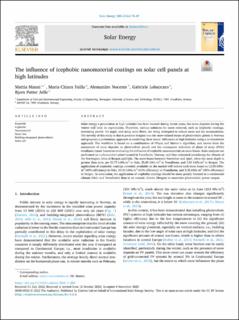| dc.contributor.author | Manni, Mattia | |
| dc.contributor.author | Failla, Maria Chiara | |
| dc.contributor.author | Nocente, Alessandro | |
| dc.contributor.author | Lobaccaro, Gabriele | |
| dc.contributor.author | Jelle, Bjørn Petter | |
| dc.date.accessioned | 2022-11-17T07:29:39Z | |
| dc.date.available | 2022-11-17T07:29:39Z | |
| dc.date.created | 2022-11-07T17:14:40Z | |
| dc.date.issued | 2022 | |
| dc.identifier.citation | Solar Energy. 2022, 248 76-87. | en_US |
| dc.identifier.issn | 0038-092X | |
| dc.identifier.uri | https://hdl.handle.net/11250/3032286 | |
| dc.description.abstract | Solar energy’s penetration at high latitudes has been boosted during recent years, but snow deposits during the winter still limit its exploitation. Therefore, various solutions for snow removal, such as icephobic coatings, increasing panels’ tilt angle, and using wind flows, are being attempted to reduce snow and ice accumulation. The novelty of this study is that it presents insights into the snow-related issues of photovoltaic plants in Norway and proposes a preliminary approach to modelling these issues’ influences at high latitudes using a co-simulation approach. The workflow is based on a combination of PVsyst and Marion’s algorithm, and moves from the assessment of snow deposits on photovoltaic panels and the consequent reduction of plane of array (POA) irradiance (snow losses) to evaluating the influence of icephobic nanomaterials on snow losses. Solar analyses are performed on a photovoltaic plant located in Trondheim, Norway, and then reiterated considering the climate of the Norwegian cities of Bergen and Oslo. The snow losses between November and April, when the snow depth is greater than zero, are 32.75 kWh/m2 in Oslo, 25.05 kWh/m2 in Trondheim, and 5.85 kWh/m2 in Bergen. The application of icephobic coatings currently available on the market will reduce such snow losses to 12.05 kWh/m2 (65% efficiency) in Oslo, 10.00 kWh/m2 (60% efficiency) in Trondheim, and 3.35 kWh/m2 (45% efficiency) in Bergen. In conclusion, the application of icephobic coatings should be more greatly boosted in a continental climate (Oslo and Trondheim) than in an oceanic climate (Bergen) to maximize photovoltaic power output. | en_US |
| dc.language.iso | eng | en_US |
| dc.publisher | Elsevier | en_US |
| dc.rights | CC BY 4.0 | * |
| dc.rights.uri | http://creativecommons.org/licenses/by/4.0/ | * |
| dc.subject | Icephobic | en_US |
| dc.subject | Nanomaterial | en_US |
| dc.subject | Snow loss | en_US |
| dc.subject | Building-integrated photovoltaics | en_US |
| dc.subject | Solar cell | en_US |
| dc.title | The Influence of Icephobic Nanomaterial Coatings on Solar Cell Panels at High Latitudes | en_US |
| dc.title.alternative | The Influence of Icephobic Nanomaterial Coatings on Solar Cell Panels at High Latitudes | en_US |
| dc.type | Peer reviewed | en_US |
| dc.type | Journal article | en_US |
| dc.description.version | publishedVersion | en_US |
| dc.rights.holder | © 2022 The authors | en_US |
| dc.subject.nsi | VDP::Teknologi: 500 | en_US |
| dc.source.pagenumber | 76-87 | en_US |
| dc.source.volume | 248 | en_US |
| dc.source.journal | Solar Energy | en_US |
| dc.identifier.doi | https://doi.org/10.1016/j.solener.2022.11.005 | |
| dc.identifier.cristin | 2070215 | |
| dc.relation.project | Norges forskningsråd: 244031 | en_US |
| dc.relation.project | Norges forskningsråd: 324243 | en_US |
| cristin.ispublished | true | |
| cristin.fulltext | original | |
| cristin.qualitycode | 2 | |

